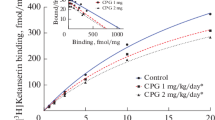Abstract.
Factors influencing the disappearance of radioactivity from mouse brain after injections of tracer doses of the very selective receptor antagonists [3H]raclopride and [3H]robalzotan (NAD-299) which bind with high affinity to dopamine-D2 and 5-hydroxytryptamine1A receptors, respectively, were studied. For both ligands the amount of radioactivity in cerebellum was taken as non-specific binding and subtracted from the amount of radioactivity found in the brain regions studied. The disappearance of the radioactivity in naive mice followed apparent first-order reactions with T 1/2=16.8±1.4 min for [3H]raclopride in striatum and T 1/2=22±2 min and 17±2 min for [3H]robalzotan in hippocampus and frontal cortex, respectively. Pretreatment of mice with 1 mg/kg s.c. reserpine 20 h before the experiment strongly prolonged the dissociation phase for the two ligands. Injection of the dopamine-D2 receptor antagonist etioclopride 1 h after [3H]raclopride in the reserpinized mice rapidly reduced the radioactivity in striatum to the same level as in cerebellum. Similarly, the 5-HT1A receptor antagonist WAY-100,635 injected 1 h or 4 h after [3H]robalzotan rapidly reduced the radioactivity in hippocampus and frontal cortex to the cerebellum level showing that the intact drugs were still bound to the receptors. In reserpinized mice kept at 30°C 1 h before and during the experiment, which normalised the body temperature, the disappearance of radioactivity was more like that in untreated animals but was still significantly higher than in the control animals. Mice treated with anaesthetic agents, e.g. γ-butyrolactone (GBL), pentobarbital sodium and chloral hydrate, also strongly prolonged the rate of disappearance of [3H]raclopride and [3H]robalzotan from the receptor-rich brain regions. The pronounced effect of hypothermia on the dissociation of these 3H ligands from their receptors is probably caused by a general decrease in brain nervous activity. However, the decreased rate of dissociation evoked by reserpine, GBL, baclofen and prazosin after normalisation of the body temperature may be due to specific actions of these compounds causing decrease in dopaminergic and serotoninergic nerve activity which results in reduced synaptic concentration of the transmitter amines. In accordance with this view, increased synaptic 5-HT evoked by the 5-HT releasing agent p-chloroamphetamine enhanced the disappearance of [3H]robalzotan from hippocampus and frontal cortex.
Similar content being viewed by others
Author information
Authors and Affiliations
Additional information
Electronic Publication
Rights and permissions
About this article
Cite this article
Stenfors, C., Ross, S.B. Hypothermia reduces the rate of dissociation of specific ligands from dopamine-D2 and 5-hydroxytryptamine1A receptors in the mouse brain in vivo. Naunyn-Schmied Arch Pharmacol 364, 479–486 (2001). https://doi.org/10.1007/s002100100465
Received:
Accepted:
Issue Date:
DOI: https://doi.org/10.1007/s002100100465



